

From the Inside Out:
The Cork Extractors of John W. Milam and John Sheridan
by Josef L'Africain. Originally published in The Bottle Scrue Times - 2019
As many of you know, I love to research the corkscrews and cork extractors that we each covet. And, as mentioned in the past, the continuing digitization of old periodicals and documents has netted out a plethora of information to dig through…albeit virtually.
This ongoing hunt can often turn up with very little, as not all past periodicals are readily available. There can be other times when a search for “cork extractor” for example, can garner an old illustration with a description of a yet-to-have-been-found patent.
Better said, we may have known about the patent itself, thanks to Fred O’Leary and the inclusion of all the patent drawings that appear in the back his book on American patented corkscrews—affectionately referred to as the “Back of O’Leary or BOO—but a real-life example has yet to have been discovered within our respective collections. 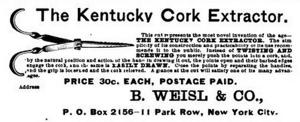
Still, when you find an article about a patented cork extractor, or when you find an advertisement for a patented cork extractor, you would have to imagine that it would have been produced at some point. We just need to find it!
Several years ago, I ran into such an advertisement for “The Kentucky Cork Extractor,” appearing in an 1891 issue of The American Angler; a magazine about fishing. The same ad also appears in a periodical entitled Nature.
This cut represents the most novel invention of the age—THE KENTUCKY CORK EXTRACTOR. The simplicity of its construction and practicability of its use recommends it to the public. Instead of TWISTING AND SCREWING, you merely push the points into a cork, and by the natural position and action of the hand in drawing it out, the points and their barbed edges engage the cork, and he same is EASILY DRAWN. Close the separating handles, and the grip is loosened and the cork relieved. A glance at the cut will satisfy one of its many advantages.
There were several questions that occurred to me in finding the advertisement. One, does this appear in the back of Fred’s book. Two, why is this appearing in a magazine about fishing? And, finally as a cork extractor, would this work?
As is often my practice, I turned to the back of O’Leary and started examining the patent drawings.
What I found, were two patents that function similarly. Each utilize serrated or barbed edges to grab the cork. Each was intended to be inserted into the middle of the cork, and once engaged, the serrated teeth grab the cork from the inside. Having bitten into the cork, the cork would be withdrawn out of the bottle. These are the Milam patent of 1888 and the Sheridan patent of 1917.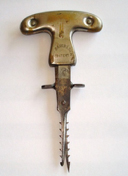
I will add here, that the only cork extractor that operates in a similar fashion that is shown in the World Class Corkscrews book, is the rare N.P. Samuelson cork extractor; patented in Demark in 1903, Sweden in 1904, Norway in 1904, Germany in 1904, England in 1904, and Austria in 1905.

On October 9,1888, John Milam was awarded patent number 390,691 for a Cork Extractor.
As described in his patent, “This invention relates to a device for extracting corks from the necks of bottles: it consists of pivoted levers having piercing prongs or fingers adapted when lying side by side, to be driven into the cork, where they may be separated and forced into engagement therewith, after which they, with the cork, may be withdrawn.”
One should also note from his patent drawings and description that his intention was to create three versions: the standard version as shown in Figure 1, a bar mount version, and a pocket version.
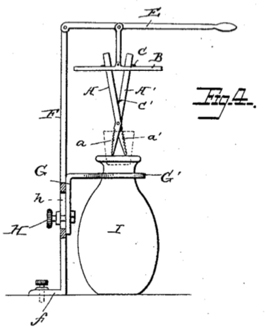
“In Fig. 4 I have shown my invention combined with an operating-lever and stand in a manner useful in constant or frequent use, as in bar-rooms.”
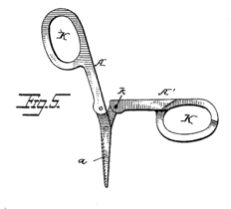
“In Fig. 5 I have shown a convenient form of the invention for carrying in the pocket. In such form the handles are provided with finger-loops K, while one or both of them are jointed, at k, to permit them to be folded down by the side of the prongs to lessen the danger of cutting or piercing the person so carrying the implement.”
In 1917, John A. Sheridan, was awarded patent number 1,240,610 for an Improved Cork Puller.
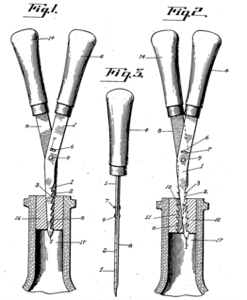
The Sheridan patent has certain similarities to the Milam, with the use of serrated edges on the blades being inserted into the cork. His patent explains his intentions;
“First, to provide an improved cork puller;
Second to provide an improved cork puller arranged to engage the cork throughout the entire length thereof;
Third, to provide an improved device of the character described that will tend to draw the sides of the cork away from the sides of the orifice when the device is pulled away from the orifice;
Fourth, to provide an improved cork puller having blades with serrated edges arranged to engage a cork while inserting the device into the cork; and
Fifth, to provide an improved device of the character described having means arranged to preserve the alignment of the blades while being inserted.”
And, the following article appears in a 1918 issue of Popular Science Monthly:
One Quick Pressure and the Cork Is Out
The corkscrew has at last found a rival in the cork-puller, invented by John Sheridan, of San Francisco. Two thin scissor-like blades, having upwardly inclined serrations, are thus into the cork body. When you close the blade handles, the serrated members open in wedge shape, and the cork can be pulled instantly. The inclined teeth draw the sides of the cork inward, making it smaller than the bottle mouth, so that it is easily drawn out. The puller can easily be withdrawn by again separating the handles. It leaves only a small hole.
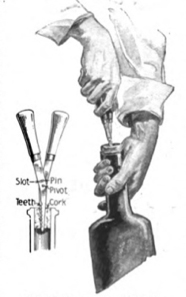
The blades are thrust into the cork, the handles pressed together
and the cork extracted.
As previously mentioned, neither patent drawing was an exact match to the Kentucky Cork Extractor as pictured in the advertisement in The American Angler magazine. The pocket version of the Milam bears the most similarities, but it clearly wasn’t the Sheridan.
So, at the time, I was unable to answer the three questions mentioned earlier. Does this appear in the back of O’Leary? Why was it in a Fishing Magazine? And, would this work? Still, I filed away the advertisement of The Kentucky Cork Extractor into a research file on my desktop, and also into my something-to-look-for-internal-rolodex.
Three years after finding the advertisement, I found some answers.
As it happened, I ran across a familiar looking tool, with the most interesting description from the person selling it, on a non-eBay website; described as “J.W. Milam, Frankfort, Kentucky, Fishing Tool Corkscrew.”
In their description of the item, the seller explained how they came to believe it was some sort of corkscrew, explaining, “I don’t know if this is a corkscrew or not, but I found it amongst a box of other vintage corkscrews.”
As I glanced at the image, I knew it looked familiar, but it had been a few years since I had run across the advertisement. Still, I promptly paid their asking price.
After securing the deal, I returned to the back of O’Leary. Yes, the 1888 patent was J.W. Milam. And, while the Kentucky Cork Extractor as shown in the advertisement, does not exactly look like the patent drawing, it does come close to a combination of Figure 1 and Figure 4 in his patent drawings. Further, it is marked “J.W. Milam, Frankfort, Kentucky,” and “PATAPPLIEDFOR.” And, it is spot on in comparing it with the advertisement.

Answer to question one: Yes, it does exist within O’Leary, but in a slightly different form.
 As far as the appearance in a fishing magazine question. J.W. Milam, was the son of B.C. Milam, who made fine fishing reels. B.C. Milam & Son (that son being J.W.) fishing reels were the reel of choice of three American Presidents, Grover Cleveland, William McKinley, and Theodore Roosevelt, and were awarded four international first prizes and medals at the Chicago World’s Fair, Fisheries Exposition in Bergen, Norway, at the World's Exposition in Paris, France and at the St. Louis Exposition in Saint Louis. Today, a B.C. Milam & Son fishing reel can fetch from the hundreds of dollars well into the thousands to fishing reel collectors.
As far as the appearance in a fishing magazine question. J.W. Milam, was the son of B.C. Milam, who made fine fishing reels. B.C. Milam & Son (that son being J.W.) fishing reels were the reel of choice of three American Presidents, Grover Cleveland, William McKinley, and Theodore Roosevelt, and were awarded four international first prizes and medals at the Chicago World’s Fair, Fisheries Exposition in Bergen, Norway, at the World's Exposition in Paris, France and at the St. Louis Exposition in Saint Louis. Today, a B.C. Milam & Son fishing reel can fetch from the hundreds of dollars well into the thousands to fishing reel collectors.
Given that the Milam brand was already a presence in fishing magazines of the time like The American Angler and Nature, it makes sense that the Kentucky Cork Extractor would be advertised in these publications.
Answer to question two: The manufacturers of the Kentucky Cork Extractor produced fishing reels as their primary business.
Finally, does it work?
The short answer, would be yes. When you insert prongs of the Milam into a cork, and then pull on the handles, the serrated prongs do bite into the cork. So, with a little extra pulling effort a cork would be able to be extracted.
While I have yet to actually pull a cork with it, perhaps if I find an older 375 ml of Sauterne with a softer cork, I might give it a go.
This would be a “new” discovery from the back of O’Leary, and a wonderful addition to the collection. Now, we just need to find the Sheridan patent!.
If you have any cork extractors that function in a similar fashion, drop me a line!